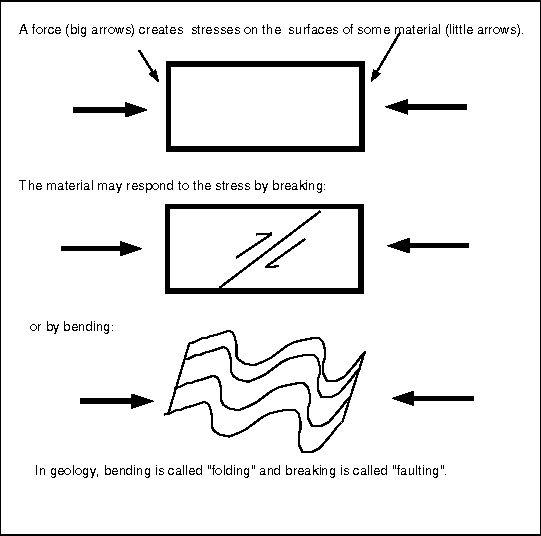
Lisa Tauxe
In the preceding lectures you have become aware of the fact that the Earth is a dynamic place. Churning deep within the Earth results in movements of lithospheric plates at the surface. The movements are accomodated mostly at the regions near the boundaries between lithospheric plates. At these plate boundaries, tremendous forces are at work, bending or breaking solid rock. The study of these bent and broken bones of the Earth that constitutes the field of Structural Geology.
When I was in high school, I spent some time on a mountain in the middle of Europe. A friend of mine picked up something from the ground and we saw to our astonishment that it was a sea shell! How in the world did a sea shell get up to the top of the Swiss Alps? In fact, mountains are formed in a variety of ways. Volcanic activity makes volcanoes, which are often high enough to be called mountains (Mount St. Helens!). Mountains also form in response to stress in the lithosphere. This is a process known as orogeny. Rocks fold or fault (break) as a result of applied stresses and this folding and faulting makes mountains. This brings up a more fundamental question yet:
Everyone has heard the word "stress". The physical scientist, however,
has a special meaning for the word, which is different from the popular
meaning. Stress is defined as a "force per unit area". Force
also has a special meaning in science and is defined as "mass x
acceleration". When you fall, you are pulled by the force of gravity.
When you land, your body presses against the Earth with a force per unit
area creating a stress. Now imagine the response of a block of material
to an applied stress:

If the stress exceeds the strength of the material, it can break. If the rock simply breaks but no relative motion occurs, the break is called a joint. Breaking is the domain of brittle deformation and when relative motion occurs between two pieces, it creates what geologists call a fault. If the stress is applied slowly enough and the material is "soft" enough, it may flow. This is called ductile deformation and creates what geologists call folds.
You might expect normal faults to form where crust is being pulled apart, ie at spreading centers. Similarly, you might expect thrusting where crust is being pushed together, i.e. at subduction zones. Finally, you might expect transform faults to be "strike-slip".
Folds form when the deformation rate is slow enough, the material is soft enough, or the compressive stresses high enough to permit flowing of material as opposed to breaking. Therefore, ductile deformation usually occurs at depth or in soft rocks such as sedimentary rocks.
Know the meanings of these words:
syncline, anticline, strike, dip, plunge, axial plane, overturned fold (see Figure 10.12 in your book).
The job of a structural geologist is to tell a story of what happened in a particular place. Examine figure 10.28 in your book. The geologist observes (e) (or at least the horizontal projection of (e), and infers the story in 1-d.
Example from the Appalachians.
Discuss Figures 21.8 and 21.9 from book.
Lisa Tauxe